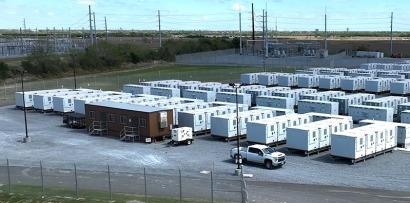
These battery storage projects are designed to address a number of grid challenges, providing flexibility to PGE’s grid operators to meet changing conditions and help manage costs. Stored energy can be reliably deployed within seconds to customers during extreme weather events or times of high demand, reducing dependence on energy markets and fossil fuel generation.
The projects include:
Seaside: A 200 MWac facility, to be owned and operated by PGE, located in North Portland and delivered by Eolian, L.P. (Eolian). Seaside has been developed by Eolian since 2017 and is expected to begin service by the middle of 2025.
Troutdale: A 200 MWac facility, owned and to be operated by NextEra Energy Resources and developed by Eolian since 2018. This project is located at a key substation in Troutdale and is expected to begin service by the end of 2024. PGE will purchase the output from a subsidiary of NextEra Energy Resources through a 20-year Storage Capacity Agreement.
“Battery storage is an important component of the clean energy economy. These new, Oregon-based projects are a significant addition to our wind, solar and hydro resources — providing grid reliability, resiliency and flexibility while helping us manage costs,” said Maria Pope, CEO and President at PGE. “At PGE, we are leading the way to a clean energy future reliably and affordably.”
Project details
These battery energy storage facilities allow PGE to optimize the renewable power in its portfolio and deliver electricity even when the sun isn’t shining and the wind isn’t blowing. As PGE integrates more intermittent clean energy resources, like wind and solar plants, battery storage systems provide consistency, facilitating the reduction of greenhouse gas emissions and making progress toward Oregon’s 2030 clean energy target.
Both projects will feature four-hour duration lithium-ion battery storage. Collectively, the 400 MWac can provide enough emissions-free electricity to power about 260,000 homes for four hours during times of typical peak demand (5 – 9 p.m. on weekdays).
“Anticipating the need for resilient, flexible and carbon-free grid-balancing resources to serve the dynamic growth of the Portland metro area led us to focus on the development of battery energy storage sites at key substations directly serving load in the region,” said Eric Stoutenburg, Director of Energy Storage at Eolian. “PGE’s groundbreaking energy storage acquisition will utilize proven technology to improve grid reliability while accelerating the integration of increasing volumes of renewable energy with the flexible capacity provided by these systems.”
“PGE is truly taking the lead in providing a clean energy future for the residents of Oregon and we are pleased to continue to work with them to help them achieve their decarbonization goals,” said Rebecca Kujawa, president and CEO of NextEra Energy Resources. “The Troutdale battery storage project, in addition to the Wheatridge Renewable Energy Facilities, the first utility-scale energy facilities in North America to co-locate wind, solar and battery storage, really demonstrate the tremendous results that great collaboration can achieve.”
Sited locally, the new projects will bring family wage jobs and tax revenue to Oregon. Employment opportunities in the local economy supported by these projects include roles in development, engineering, construction and installation, logistics, operations and maintenance.
A piece of PGE’s decarbonization strategy
These battery storage additions, procured from PGE’s 2021 Request for Proposal, are just one example of the kinds of non-emitting energy resources PGE is utilizing to advance decarbonization and bolster resource adequacy – a strategy outlined in the utility’s recent Clean Energy Plan & Integrated Resource Plan.
Earlier this year, PGE completed the Faraday Repower & Resiliency Project, a multi-year modernization effort to improve theefficiency, reliability and operational safety of a historic hydropower plant. Additionally, Pachwáywit Fields, Oregon’s largest solar farm at 162 MW, began commercial operations this month, supported by large customers and municipalities enrolled in PGE’s Green Future Impact program. PGE purchases the output from Pachwáywit Fields, which is owned and operated by AVANGRID through a Power Purchase Agreement.
PHOTO: An aerial photograph of Eolian, L.P.’s Madero & Ignacio battery energy storage facility, a 200 MW/2.5+ hour duration storage system in Texas.

